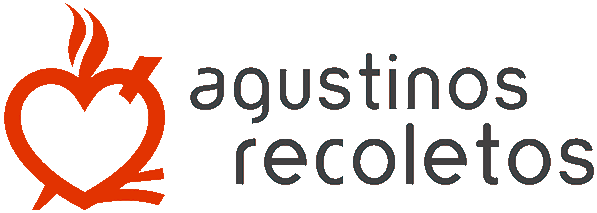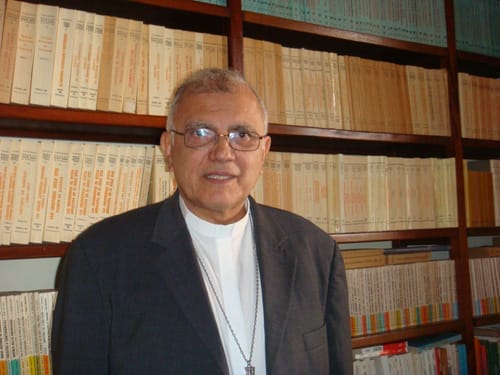—How long did you study at Fray Luis de León school?
I was a student of Fray Luis for two years. I studied my third (1952-1953) and fourth year (1953-54) of primary education. Since I was an altar boy at the parish of Saint Theresa, where my family lived, the parish priest, Monsignor Hortensio Antonio Carrillo, did not want me to continue there for fear that the friars would take me away from him, who wanted me to be like him, a diocesan priest. He conspired with my parents, offering to finance my fifth year studies at the Saint Theresa Parish School. The next year (1955-56) I entered the Minor Seminary of Caracas, where I finished my primary studies and did high school.
—What was the academic level of Fray Luis?
The academic level was excellent and demanding. Everyone knew it, and my parents were happy of my progress in my studies, in reading and in different subjects. Ever since I was young, I was attracted to humanities. There were also many opportunities for contests and tributes that encouraged studying more. Add to that the kindness of Fr. Hilario Briones, with whom I felt very much attached. Aside from his kindness, since he was also the treasurer, he always had something for us: candies, notebooks, story books. When we misbehaved, he would threaten us with the belt. His affable smile and his concern for us made him the guardian angel of the little ones. The literature professor, a Spanish lay person, was a serious man, but he was an excellent professor.
—What moral principles did they transmit? Was there religious formation? Could that have influenced your priestly vocation?
Of course, we had religious formation. But, above all, there was a discipline that, without being excessive, made us proud of our school which, though middle-class, competed in many areas with the more famous and prestigious ones. My preparation for first communion was at the school. I had it on 8 December 1952 and my teacher was Fr. Hilario. It was not often that a priest would prepare a pupil for first communion. We had daily prayers. We were brought in groups to the chapel, the church of Saint Augustine, annexed to the school; sometimes we would hear mass. It was not an oppressive kind of education, but an enchanting one. I think that that environment planted in me the priestly vocation, and my first model was Fr. Hilario. I believe that my fondness for Saint Augustine and Fray Luis de León started there and increased during my years in Salamanca.
—What did you, Venezuelan children then, think of those Spanish friars, who were perhaps somewhat brusque or rough?
Those Spanish friars – and a Venezuelan one, too, who spoke with a Spanish accent – impressed us and we would laugh at them as we would mimic them in pronouncing the z or the c, or aping words we did not understand, such as “chavales” (boys) or some verbs that seemed ill-sounding… Rather than brusque, they appeared as serious for us; but during recess, we would approach them with confidence to ask them questions or inquire about the habit…
—Do you know the Augustinian Recollects a bit more? How do you judge their past and present in Venezuela?
I knew the Augustinian Recollects since I was a child, since my father was from Táchira and the Porras family had a close friendship with Fr. Francisco Frías, parish priest of Palmira (Táchira), from where they all hailed. He was a chain-smoker, with a gravelly voice, but when we visited him with my grandmother and aunts, he would give us all sorts of gifts.
Later, I went to study theology in Salamanca. The then newly-established Augustinian Recollect seminary, which if my memory serves me right, was near the bullring, along the highway to Zamora, was an exceptional place for playing basketball. Encounters of all kinds among students of the boarding schools were then very fluid.
I remember that at the end of the second session of the Second Vatican Council, my bishop, Monsignor Salas, together with auxiliary bishop of Caracas Jesús María Pellín, stayed in Madrid for 2 or 3 days. I went from Salamanca to Madrid to see them. We took lunch at the provincial house of the Augustinian Recollects, I think it was near the Ventas bullring. It was an unforgettable experience for me: Bishop Pellín was an Augustinian Recollect tertiary and he knelt before the superior to ask his blessing. I am writing from memory, and I believe that one of the priests was Fr. Feliciano Alonso. They recalled anecdotes from their youthful years in Venezuela. They had to be smuggled into the country, in plainclothes, saying they were teachers, or masons or practitioners of other professions because the Guzmán laws remained in vigor though Gómez was already ten years in power. Regarding the purchase of the lands for the Saint Augustine church and the future school, people thought them crazy because those lots lay outside the city. I was above all impressed, – I was then 19 or 20 years old – by their love for Venezuela, where they spent the best years of their lives.
When I returned to Spain to pursue my doctorate, after Franco’s death, I had the opportunity to be in San Millán and surroundings and know more that enclave of Augustinian Recollect culture, holiness and presence. In one of those visits, I coincided with Fr. Hilario in the house of his sister. I was accompanied by the family of the Jesuit Fr. Pedro Trigo, who lived in Haro.
As a bishop, I had the occasions to visit the Augustinian Recollects in Spain as well as in Italy. I am happy that recently Fr. Eusebio Hernández was named bishop of Tarazona. His work, in relation to Latin America, is widely recognized. In the CELAM, I have for various years shared responsibilities with Bishop José Luis Lacunza, of David, Panama. In Bogotá, on the occasion of the 400 years of the Augustinian Recollection, I visited the exhibit that they mounted at the downtown church entrusted to them. And the three volumes of the History of the Order in New Granada have always been of interest to me on account of the involvement of what is now Venezuelan territory.
The history of the Augustinian Recollects in Venezuela remains to be written. The concern for native vocations has been a basic concern since way back. As proof you have the house of Palmira. Caracas, Coro, Maracaibo, San Cristóbal and recently Ejido in Mérida, witness to an evangelizing presence laden with an intense and profound spiritual legacy.
— Can you also say something about the Church in Venezuela?
The Church in Venezuela shares with the Venezuelan people and institutions present in the country a complex process that attacks their identity. Her stance of constructive criticism is not accepted by a sectarian government that embraces only unconditional friends. This has broken a long tradition of coexistence and cordiality which were characteristic of our society. We believe that the best evangelical witness include reconciliation and pardon, the quest for a pluralistic and respectful democracy, where there shine forth peace rather than violence, truth and transparency rather than manipulation by the media. Poverty is on the rise, the possibilities of employment are waning, and there is the mirage of populism that stunts the many possibilities of a society that aspires for a better future. We, believers and men and women of good will, have the duty to work for the fundamental values of a pluralistic and respectful society that is open to everyone. The Catholic hierarchy is undergoing a difficult period, because the official attacks and black propaganda are unabating. Nevertheless, it is the institution that enjoys the highest credibility and trust on the part of the majority of the people.


